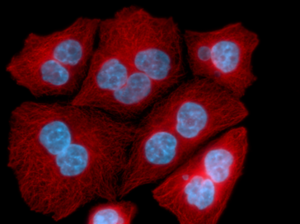Scientists uncover novel properties of key signalling molecule in cell division

A signalling factor called ECT2 is essential for cytokinesis - the physical process of cell division - to happen correctly.
Scientists have discovered that ECT2 needs to bind to the cell membrane to activate the signalling pathway that triggers cytokinesis. ECT2 also binds to the spindle midzone - a signalling hub in the middle of the cell - but the scientists were surprised to discover that this latter interaction is not crucial for cytokinesis to be carried out correctly.
Much of the research was carried out by Mark Petronczki and Kristýna Kotýnková while they were at Cancer Research UK's London Research Institute and the Francis Crick Institute. Kristýna, who is now at the Boston University School of Medicine in the USA, explains: "Cell division generates two daughter cells out of a single mother cell through the cell envelope folding in on itself to form a separate pouch at what's called the cleavage furrow. For each daughter cell to inherit the correct genetic information, the cleavage furrow has to occur at the middle of the cell, in between the separated masses of chromosomes."
She adds: "Cell division failure causes a doubling of the number of chromosomes per cell. Research suggests that this is a dangerous event that leads to further genetic instability and can trigger cancer. Doubling of genetic information is observed in some tumour cells in humans."
The scientists used optogenetics for their research - a new technique that uses light to activate various processes in a cell. They engineered cells to express different versions of ECT2 that could be controlled by illumination with blue light - meaning they could control cell division by light.
To investigate how cancer cells initiate the formation of the cleavage furrow and ensure its correct placement, the researchers studied a famous human cancer cell line called HeLa. Using these cells, they created a number of variants with different versions of ECT2 that could be directed to the cell envelope by the addition of a chemical or by illumination with blue light.
The team found that for cleavage furrow formation and cell division to occur, ECT2 has to associate with the cell envelope. There it triggers the switch that starts cleavage furrow formation. In cells where ECT2 did not associate with the cell envelope, cell division did not occur. This resulted in emerging cells undergoing a full duplication of chromosomes. However in cells where ECT2 did not associate with the spindle midzone, cytokinesis still happened correctly.
Dr Petronczki, who is now at Boehringer Ingelheim in Vienna, Austria says: "Understanding the mechanism and control of cell division in human cells allows us to understand how cells prevent the potentially deleterious consequences of cell division failure. Furthermore, finding a way to specifically block cell division in cancer cells but not in normal cells could pave the way for a safe and effective treatment of human cancers."
More information: Kristýna Kotýnková et al. Plasma Membrane Association but Not Midzone Recruitment of RhoGEF ECT2 Is Essential for Cytokinesis, Cell Reports (2016). DOI: 10.1016/j.celrep.2016.11.029
Journal information: Cell Reports
Provided by The Francis Crick Institute


















